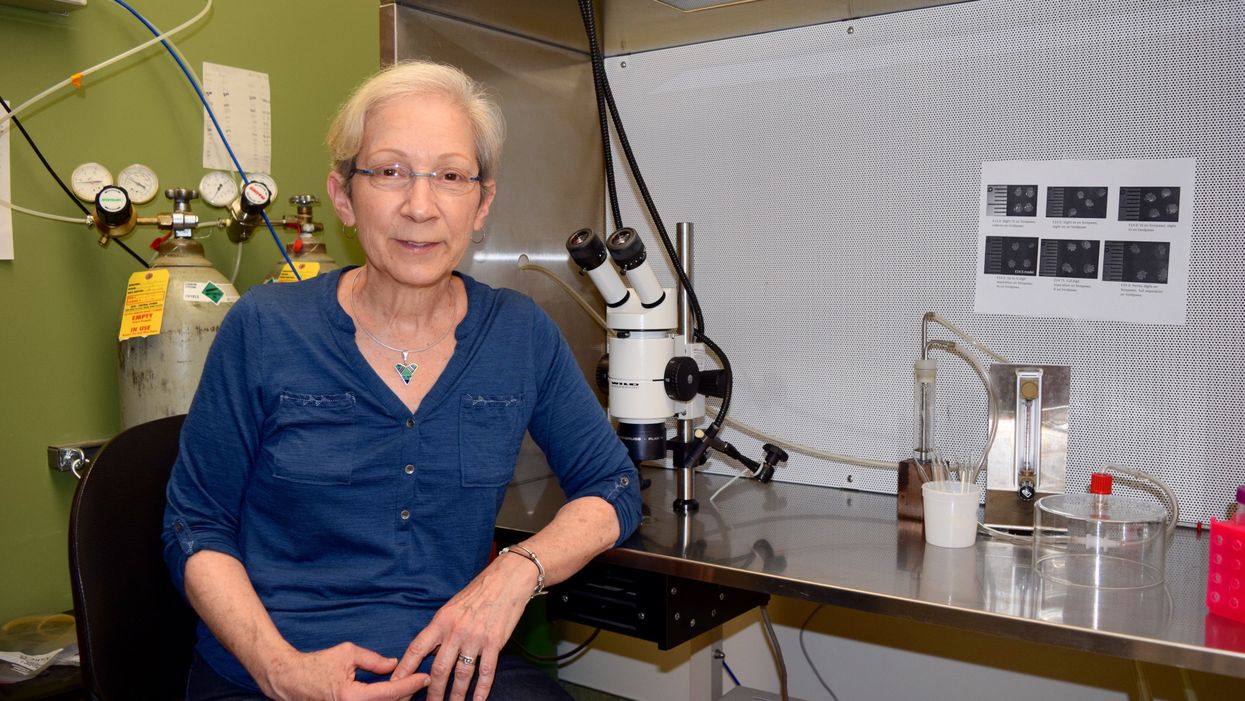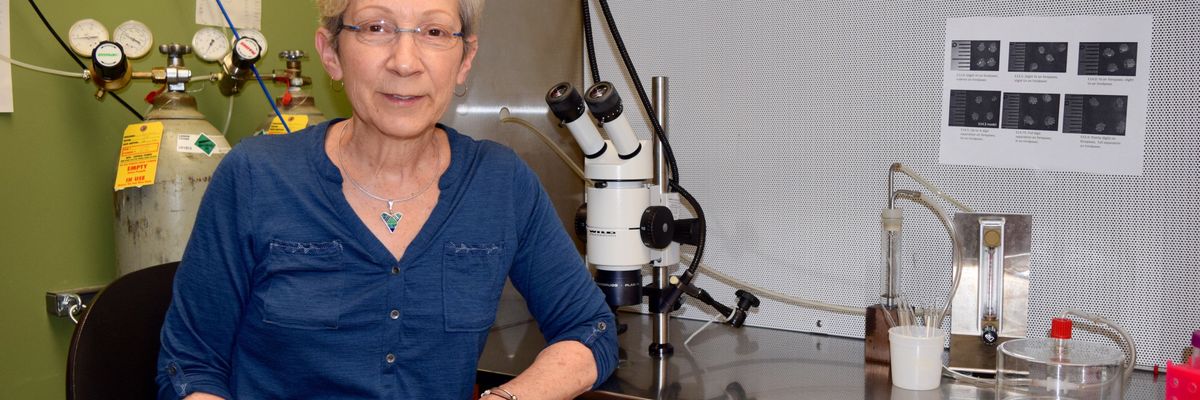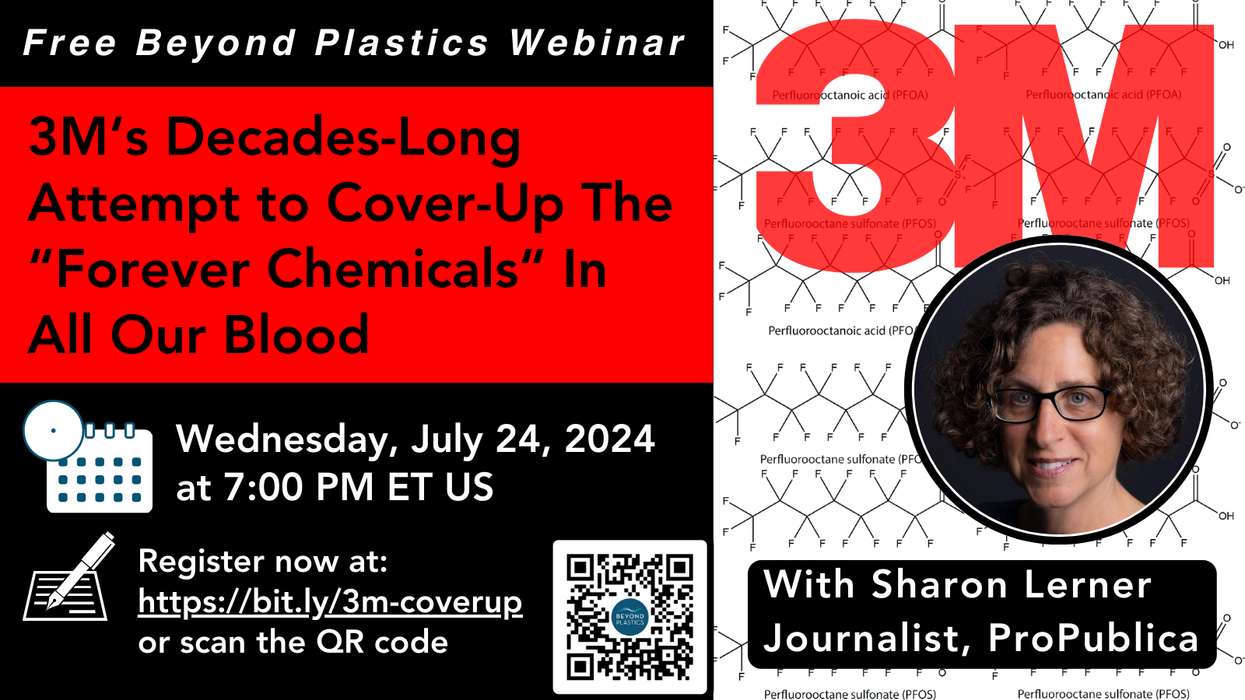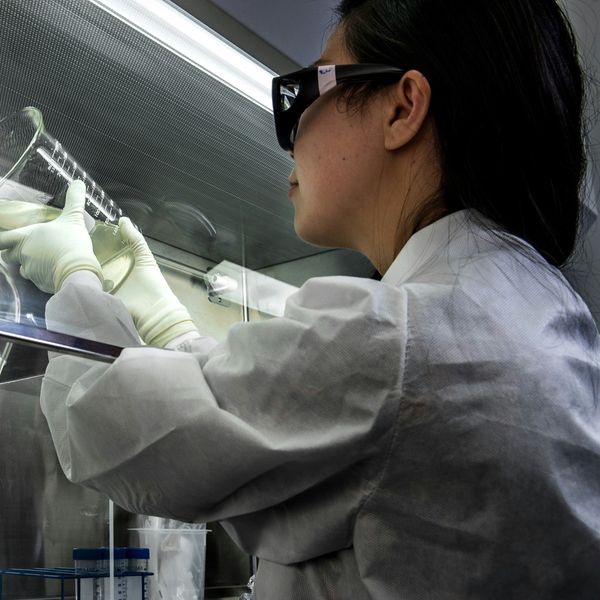This is part 2 of a 4-part investigation of the science surrounding the chemical BPA and the U.S. regulatory push to discredit independent evidence of harm while favoring pro-industry science despite significant shortcomings.
PULLMAN, Wash.—Tiny pink lab mice disappear then quickly reappear again from within a cage's hardwood chip bedding. The squirmy newborns are part of Patricia Hunt's latest series of experiments on the health impacts of industrial chemicals widely found in products we all use.
Here, in a dim basement at Washington State University, where metal shelves are stacked high with rows of plastic cages, Hunt has made multiple discoveries that call into question claims made by U.S. federal regulators about the safety of one of those chemicals: bisphenol A, or BPA.
Virtually all of us have tiny amounts of it in our blood and bodies – at least two millionths of a gram per liter of blood, the equivalent of about 14 pinches of table salt in an Olympic-sized swimming pool. The Food and Drug Administration maintains that the chemical, known to mimic and mess with natural hormones, poses no real health threat at such levels.
Hunt's results say otherwise. Since being among the first scientists to report on the harmful effects of BPA on mice in 2003, Hunt has further identified genetic abnormalities, fertility problems and other health impacts in animals at very low doses.
We encounter the chemical every day in food and beverage cans, plastic packaging and cash register receipts. And it doesn't appear to be going away anytime soon: The global BPA market is predicted to surpass $30 billion by the mid 2020s. "I'd like to vote the bisphenols off the planet. But that's not likely to happen," Hunt later tells me in an upstairs room flanked with microscopes used to view tissues from the mice. "The more immediate goal should be to change the way we do toxicity testing for these types of chemicals."
Related: A scientific stalemate leaves our hormones and health at risk
Her findings—and those of others—have implications far beyond BPA to the hundreds of other chemicals capable of wreaking similar havoc on our hormones.
Discoveries in Hunt's lab also hint at how an evaluation of a chemical can easily conclude that it is safe even if it may cause harm. Twice now, Hunt has found BPA or one of its equally troublesome replacements, such as bisphenol S, coursing through the bodies of her control mice — animals not intentionally dosed with a chemical in her experiments. The source: those plastic cages housing the mice.
Natural wear and tear of Hunt's cages and, more recently, potential cross-contamination in a shared wash area from another facility's damaged plastic cages, likely led to tiny amounts of the chemicals getting into the animals. She has had similar misadventures with contamination from phytoestrogen-laden mice chow, wildfire smoke and cleaning products. Such unplanned exposures could dilute differences in health outcomes between a study's experimental and control animals, making it difficult to detect if a chemical truly poses a health risk and, ultimately, making it all the easier for hazardous things to continue finding their way into our bodies.
Both times Hunt found bisphenol contamination, she essentially lost her experiment. "It was a whole lot of déjà vu all over again," said Hunt, who is in her mid-60s, her face framed by rimless glasses, cropped gray hair and small hoop earrings.
Hunt's repeated frustrations point to just one of the myriad ways a study's design, implementation, analysis, interpretation and presentation can diminish, obscure or even totally hide any true health effects of a chemical. The risk of such oversights may be especially high for BPA and other chemicals that interfere with the action of hormones in the body, a class called endocrine disruptors.
An investigation by EHN suggests that an ongoing multimillion-dollar project called Consortium Linking Academic and Regulatory Insights on BPA Toxicity, or Clarity, includes a number of these potentially harm-hiding elements. Launched in 2012 by the U.S. Food and Drug Administration (FDA), the National Institute of Environmental Health Sciences (NIEHS) and the National Toxicology Program (NTP), Clarity combines a traditional regulatory toxicology study from the government and investigational studies from academics who wield more modern techniques. The goal is to reconcile a long-standing dispute over data and conclusions on BPA's health effects. But it's bigger than BPA—the collaboration aims to determine if the study methods used by government regulators are sufficient to determine the safety of the hundreds of chemicals suspected of being endocrine disruptors. The implications could reverberate through the entire U.S. chemical regulatory structure.
FDA officials continue to claim that concerns over low-dose effects of BPA are unfounded; academic scientists continue to publish studies that underscore risks such as altered brain development, cancer and diabetes.
Through interviews and emails obtained via Freedom of Information Act requests, EHN has uncovered various signs of deficiencies in the FDA's science on BPA and its handling of Clarity. While each sign alone could be considered a red flag, viewed as a whole, they suggest that the FDA is missing some big warning signs about BPA and, therefore, likely misleading the public about its safety.
Some of these signs can be traced back to before the study began. For example, evidence of BPA contamination emerged during a preliminary Clarity study. If the animals in the main Clarity study had been contaminated, that would dilute any true differences between exposed and unexposed groups. And during the study's design, the FDA insisted on using a specific type of rat that had been shown to be insensitive to the effects of estrogen and its mimics, including BPA. Michael Hansen, a senior scientist for Consumer Reports, compared using this rat to operating a radar gun that doesn't detect speeds under 100 mph and then concluding that no one is speeding. "It is almost as though they were trying not to find differences," Hansen told EHN.
Other potential red flags popped up during the course of the study, such as the small number of animals provided to some of the academic scientists — also limiting their ability to detect differences — and a public statement on BPA's safety made by the FDA before all the data was in.
"Is it total incompetence or fraud? I don't know their thinking. But neither choice is pleasant, and it represents the waste of about $15 million in public funding," Pete Myers, CEO and chief scientist of Environmental Health Sciences, told EHN. (Editor's note: Myers is also the founder of EHN, though the publication is editorially independent.)
An integrated report that pulls together government and academic findings is in preparation and expected by the end of 2019. Eight of the 14 academic investigators have so far published 14 papers based on their findings in a scattering of different peer-reviewed journals such as Endocrinology and Toxicological Sciences. Many found health effects in rats exposed to very low levels of BPA. "There isn't one big publication coming out with the academics' results," Gail Prins, a researcher at the University of Illinois at Chicago and Clarity investigator, told EHN. "I'm afraid that significant findings across academic studies are going to be buried."
Federal regulators have also now published their part of Clarity, one big publication known as the Clarity Core Study that was widely publicized. Their results, too, reveal some effects at low doses. Yet they again concluded in their report — and in the accompanying press — that exposing rodents to BPA did not result in health effects at the low doses to which people are generally exposed.
"I think that a lot of this is failure by design," Laura Vandenberg, an environmental health researcher at the University of Massachusetts-Amherst's School of Public Health and who was not involved in Clarity, told EHN.
Strains on relationships

The lab of Cheryl Rosenfeld, a biologist at the University of Missouri and another Clarity investigator. (Credit: Cheryl Rosenfeld)
Ila has just returned from her first puppy training class as I arrive at Hunt's home in Moscow, Idaho. Labradoodles are known to have a lot of energy, and Ila's bouncy greeting of this newcomer corroborated that reputation. Hunt tells me she is surprised Ila has yet to hurdle the childproof gate that separates the mudroom from the dining room. "I keep thinking she could hop over it so easily, but she just never does," says Hunt.
Other dog breeds may be calmer, but Hunt and her husband had good reason to go with a labradoodle: The breed sheds less fur and other allergy-triggering substances than other breeds. "We had a lab once before and the hair was everywhere, and our allergies were terrible," she says. Sure enough, I made it out of her house without any of Ila's dark brown fur.
Like dogs, lab animals can be diverse in their behavior and biology.
To determine the impact of a chemical, scientists track various changes, called endpoints, in an animal such as organ weight, tumor development, changes in behavior or insulin levels. Different strains of different rodents are often used in different studies. Hunt and many others who investigate the impacts of hormones and hormone mimics often opt for strains of mice. For one, the animals can be more practical — they eat less and take up less space than rats. Certain strains of mice are also known to be particularly sensitive to hormone changes.
"If your animal model can't respond to your experimental manipulation, then you can never determine if the manipulation does anything, ever," Scott Belcher, a biologist at North Carolina State University, and a Clarity investigator, told EHN.
Belcher, too, tends to use mice in his studies of impacts on the heart. "Rats and mice aren't the same things," he said.
The FDA's go-to animals for chemical toxicity testing are Sprague-Dawley rats bred at the FDA's National Center for Toxicological Research in Jefferson, Arkansas. These were the animals chosen for Clarity, despite objections from some academic investigators. The rats have long been used in government regulatory studies, and they have long been known to have low sensitivity to BPA.
Related: Want this story in comic strip form? Check out "Clouded in Clarity"
Jerry Heindel, the health scientist administrator at NIEHS when Clarity was initiated, noted one particularly unusual characteristic of the rats. "Estrogen stimulates puberty in a female animal. You can generally make puberty come up two, three days earlier by giving an animal extra estrogen," he told EHN. "But in this animal, you can't." A couple days early is relatively significant for an animal that, on average, hits puberty at 38 days.
"So some endpoints are going to be insensitive or much less sensitive. There's no getting around that," said Heindel. (The FDA did not respond when asked about the choice of study animal.)
Of course, animal studies all have their limitations. The only way to be relatively sure of a chemical's effect in humans would be to study the effect of that chemical in humans. In a first-of-its-kind study published in 2018, researchers exposed a small group of people to a very small amount of BPA and saw a link to a precursor of type 2 diabetes. The researchers first lowered participants' BPA levels and then brought those levels back up to the normal range. (Myers was an author on the paper.) Still, to knowingly expose people to something suspected of being harmful can raise some ethical concerns. Epidemiological studies do the next best thing — they take advantage of the natural experiment currently underway by estimating levels of exposure and health outcomes in people and then determining if and how the measures might be related.
In his epidemiological studies, John Meeker, an environmental health scientist at the University of Michigan School of Public Health, has uncovered evidence that BPA may alter circulating levels of hormones and birth outcomes. He laments how regulators have remained reliant on animal toxicology studies. "We need more harmonization of animal and human research in the regulatory setting," he told EHN.
Both research methods have their place. Toxicology studies allow scientists to directly compare exposed and unexposed animals, control the experimental environment and precisely measure outcomes. Meeker noted that his epidemiological findings do not always match up with toxicology studies. "When they do match up, it gives you more confidence," he said. "When they don't, it could be due to chance in human studies or due to species differences in their responses to exposure."

Thomas Zoeller, a biologist at the University of Massachusetts, Amherst, and Clarity investigator in his lab. (Credit: Umass.edu)
Thomas Zoeller, a biologist at the University of Massachusetts, Amherst, suggested such species differences resulted in what he called "unprecedented" findings in his Clarity study. "This is a very odd strain of animal," he told EHN.
For a century, explained Zoeller, researchers including himself have studied the impact of thyroid hormone insufficiency on brain development in animal models. "Nobody sees a lack of effect," he said. Zoeller treated some of his Clarity rats with a medication used for hyperthyroidism, propylthiouracil, that suppresses thyroid activity. And while it did succeed in altering thyroid hormone levels, as expected, the brains of his rats appeared almost unfazed.
"The data that we have show that these animals are different," added Zoeller. "They may just be different with respect to the thyroid system. But I doubt that." He suggested that because the strain was selectively bred to be prolific breeders over many generations, other changes likely accompanied the increased fecundity.
The impact of species differences can go both ways, explained Patrick McKnight, a measurement scientist at George Mason University in Fairfax, Virginia. Using a model animal that is overly sensitive to the agent of interest can artificially inflate the size of an effect, he told EHN.
Still, Linda Birnbaum, former director of the NIEHS and the NTP, shared the academics' concerns. "When we started this study, I remember having nightmares thinking, 'What happens if we don't find anything?' Because we really didn't have much data on using this strain of rat and BPA," she told EHN. "In retrospect, if I were to do this study again, I probably would've done it in mice and I probably would've used a strain which had been reported to have clear effects."
Vandenberg added her worries. "Why are we using this strain to test all chemicals if we now have evidence that it is not the right strain?" she added. "Have we made a mistake on everything?"
Power struggles

Linda Birnbaum, former director of the NIEHS and the NTP, speaking at Northeastern University's Our Environment, Our Health event in 2016. (Credit: Matthew Modoono/Northeastern University)
Even when assuming a chosen animal is a reasonable model to test a chemical of interest, the next critical factor for a successful study is enlisting a large enough number of those animals to detect health effects if there are effects to be detected. The more animals, the more so-called statistical power a study has to reveal the true effects of a chemical.
Prins believes that the FDA shortchanged her on animal numbers. She had determined prior to the study that she would need at least 18 animals per treatment group to have adequate power to detect differences between the groups. Yet for one of her treatment groups she received just four animals. "When you get that number of animals, you can't get a significant effect," Prins told EHN. "I would go out on a limb and say this was done intentionally."
In a 2008 federal review of the evidence on BPA, the FDA excluded a study of hers from their risk assessment because, in part, her study didn't include enough animals. That FDA assessment, which ended up relying on just two studies — both funded by industry — restated the agency's stance that BPA is safe.
"The FDA wants to tell a story," said Prins. "They want to tell the story that BPA is fine. And it's not."
Another Clarity researcher, Jodi Flaws, struggled with a similar power problem in her Clarity research. She ended up with just three animals in one of her treatment groups, Flaws told EHN, because the tissue sent to her by the government was not collected on the same day of the animals' menstrual cycle — a critical detail that she had requested.
Her team still managed to publish a paper with their results, which indicated that BPA exposure at some doses altered hormone production and the number of developing eggs in female rats. But she told EHN that the small number of animals underpowered them to see the stronger results in Clarity that they had seen in their prior studies.
"There was no way to make sense of anything," said Flaws, who studies genetic and environmental factors that affect the female reproductive system at the University of Illinois at Urbana-Champaign. (The FDA did not respond to a question regarding the number of study animals provided some researchers.)
John Bucher, a senior scientist with NTP and NIEHS, and one of the Clarity leads, acknowledged this shortcoming of Clarity. "We recognize that some of the investigators didn't get as many samples as they would have liked. And that's regrettable," he told EHN. "This was an enormously complicated study and we tried to accommodate as many requests as possible.... We probably overpromised."
Dirty data
On Hunt's office wall in Pullman hangs a framed quilt made by the Sarum Quilters of Salisbury, England. The primary-color design depicts the DNA double helix, genes, eggs and sperm that have been the primary characters in her 40-plus years of research. Other genetics references fill the room — there is the thick blue Dictionary of Genetics, and the half-moon table braced by arms and a back that are shaped as x and y chromosomes.
Human-made chemicals only began to take center stage in the latter half of Hunt's research career. In fact, before 1998, Hunt knew nothing about BPA. She was simply investigating at the time how hormonal changes in mice might affect the quality of a female's eggs. Then, some unexpected data began to emerge: Abnormal eggs appeared in both her experimental and control animals. "We knew we had a problem," said Hunt, wearing a dog-fur-free blue long-sleeve t-shirt and dark blue jeans, along with a multi-colored stone pendant. "It took me a month to track down what was going on."
At first, she suspected everything — from construction project debris to pesticides sprayed nearby. Then she took a closer look at the plastic cages. As they were repeatedly washed and autoclaved, she could see that the cages were starting to degrade. Across the street from her lab was the university's polymer sciences building. She recalled running over to those scientists and learning from them that BPA was likely leaching out of her cages.
While some health effects of BPA were already suspected by the late 1990s, impacts on female eggs — and, therefore, potentially increased risks of miscarriages and birth defects — were not yet among them. Hunt spent the next three years confirming her data. Today, female reproductive problems are included with the published risks associated with BPA exposure. Hunt has continued to investigate how BPA and other endocrine disruptors might further affect genes and reproduction. And, while not a participating scientist, she is also keeping a close eye on Clarity.
In emails and PowerPoint slides obtained by EHN, FDA scientists acknowledged as far back as July 2013 that contamination occurred in a study done to determine Clarity's feasibility. During this preliminary study, which was carried out at the same facility that later housed the animals used in the large-scale Clarity study, tests had revealed that BPA levels in control rats were similar to those in the four lowest exposure groups.
That's a problem: Endocrine disruptors, like natural hormones themselves, can impact the body at extremely low levels. So, unintentionally exposing controls to a tiny dose of a chemical may result in those animals showing similar effects as experimental animals intentionally exposed. In a comparison of health effects between the control and experimental animals, any true differences between the groups would be diluted.
In January 2014, Barry Delclos, a biochemical toxicologist with the FDA, wrote in an email that, while data from the preliminary study revealed "the potential for significant effects in the low BPA dose range," the BPA contamination "confounds the interpretation of the changes observed in the lowest BPA exposure groups."
Marianna Naum, an FDA spokesperson, told EHN in an email that data suggesting contamination of the control rats might have been due to "the housing of the animals in the same room as animals treated with high BPA doses." Although Naum also noted that the agency has still not confirmed the source of contamination, and that it remains unclear to what extent any contamination might have affected the rats in Clarity. Still, the government's Core Study report asserts that contamination was not an issue.

Heather Patisaul, a professor of biology at North Carolina State University and a Clarity investigator. (Credit: NCSU)
"The fact is, they don't know where the contamination came from and they don't know if the Clarity controls were contaminated," said Zoeller. "They didn't measure it."
"If you can't ferret it out, it's like shooting yourself in the head before you even start the study," added Hunt.
Birnbaum expressed little concern about that potential contamination. "When we deal with environmental chemicals, almost everyone — or every animal — has some exposure," she said. "Control doesn't have to mean zero — it means you know what you have and it is lower than the intentionally exposed."
Hunt still maintained that contamination with an endocrine-disrupting chemical could derail a study. "If you have contamination, you don't have a control. There's no way around it," she said. "It puts a shadow over the whole thing."
Food issues
It was unlikely a pleasant experience to be a Clarity rat. Every day, while restrained, a lab technician stuck a tube down its throat and into its stomach to deliver a solution. For the experimental animals, the solution contained BPA. For the controls, it either contained a dose of ethinyl estradiol, the synthetic estrogen in oral contraceptives, or nothing. The method is called gavage.
FDA scientists argue that gavage is a better way to ensure the correct dose is getting into an animal than putting the chemical in its food. Academic scientists counter that gavage triggers chronic stress and can therefore significantly alter hormone levels — another means by which any actual differences between experimental and control animals could be artificially diminished. Because the control animals were also exposed to the stress of gavage, they argue, there was no true control group of rats in Clarity.
Heather Patisaul, a professor of biology at North Carolina State University and a Clarity investigator, co-authored a 2013 study in which she found that gavage alone was enough to change the expression of hormone receptors and other genes in areas of the brain that are known to respond to stress.
"Clearly animals gavaged and not gavaged are not the same," she told EHN.
During the planning of Clarity, the FDA made it clear that use of gavage was non-negotiable, noted Heindel, the former NIEHS health scientist administrator. The academics could accept that or simply not participate.
So, many reluctantly signed on, despite believing that gavage and other design factors dictated by the FDA would make it extra difficult to show effects that many of them had identified in their previous studies. Use of gavage was among the criteria adopted by the government decades ago for studies that evaluate the safety of chemicals. In addition to standardizing the number and type of animal used, and levels of exposure to the chemical of interest, these so-called "guideline" studies also generally focus only on traditional endpoints such as overt signs of toxicity, rather than the unique effects of endocrine-disrupting chemicals that academics tend to investigate.
Academics usually use other means of administering chemicals to animals. Prins delivers BPA into a mouse's mouth with a pipette tip. Andrea Gore, a neuroendocrinologist at the University of Texas at Austin, said her lab is starting to administer chemicals to animals via vegetable oil placed on a piece of cookie. "There is evidence that gavage is stressful," Gore, who was not involved in Clarity, told EHN. "When you're talking about low doses of endocrine-disrupting chemicals, that is extremely relevant."
Hunt, too, feeds her mice BPA via corn oil. "We gently pipette oil into the mouth and the animals actually like it," she said.
Losing control

Researcher Pat Hunt with lab mice. (Credit: Lynne Peeples)
Whenever it is wet outside, Hunt makes sure to clean off Ila's four paws before they come inside. "We pause for paws," she said. Given the puppy's high energy, it is a given that the outside mud would end up just about everywhere inside her house. Yes, Hunt is familiar with both dirty dogs and dirty data — and the struggle to keep puppies and studies under control.
Contamination is one of the ways in which a study and its results might become tainted; a lack of control is another.
Standard protocol for research on endocrine disruptors demands the inclusion of both "positive" and "negative" controls — groups of animals that researchers can then use as a baseline comparison against their exposed group of animals. A negative control is your typical study control animal that doesn't receive any exposure. (Again, in the case of Clarity, academics argue that this purity was spoiled by potential contamination.) A positive control is exposed to something with a known response.
For example, academic studies of BPA have generally included a group of animals exposed to a synthetic hormone for which effects are well known: ethinyl estradiol, the estrogen mimic in oral contraceptives. This positive control helps scientists decipher whether or not a lack of an effect in BPA-exposed rats compared to negative controls was because the experiment simply did not have the sensitivity to detect estrogen-like effects or because BPA really had no such effect.
When the government initially declared their plan not to include positive controls in Clarity, according to emails reviewed by EHN, 11 of the academic researchers pleaded for them to reconsider. In one of the emails from April 2012, Frederick vom Saal, a professor of biology at the University of Missouri-Columbia and a Clarity investigator, stated that without these controls, the experiment could "waste millions of dollars and generate uninterpretable data."
Positive controls were eventually provided and used for most, but not all, of the Clarity studies. Kim Boekleheid, a toxicologist at Brown University, was the only academic scientist not to use a positive control in his study of male reproduction. His decision ignited ire among some of his Clarity co-investigators, especially upon the release of his results. While previous academic studies have found that male reproduction is very sensitive to BPA, Boekleheid's study concluded that exposure to BPA did not harm the testes or sperm in rats. Hunt and others question how he could be so sure without a positive control. Boekleheid declined to be interviewed for this story.
An additional type of control was enlisted by the government in their Core Study. When they found higher rates of mammary cancer in rats exposed to low doses of BPA compared to negative controls, the FDA authors then also looked to a control group from a somewhat similar study conducted about a decade earlier. Turned out those non-BPA-exposed animals, considered "historical" controls, developed more mammary tumors than the non-BPA-exposed rats in the Clarity study. The government used this as one of their reasons to disregard the mammary cancers as a true BPA effect.
Outside scientists questioned their motives and noted, for example, that the animals not exposed to BPA in the old study would have been housed in plastic cages made partially of BPA. So, those rats may, too, have been inadvertently exposed to small doses of BPA. Gore added that "things change over 10 years." In work in her own lab, she has found that animals vary across generations — "even if they are the same strain, fed the same food and all animal husbandry is done the same."

Ana Soto, an endocrinologist at Tufts University and a Clarity investigator, with fellow Tufts researcher, Carlos Sonnenschein (Credit: Tufts University).
Ana Soto, an endocrinologist at Tufts University and a Clarity investigator suggested that historical controls are typically only used when a difference is not seen between an experiment group and control group. "They are doing the opposite. They seem to be trying to minimize the fact that they found differences between BPA-treated and the simultaneous control," she told EHN. "That is where you start wondering whether this choice is plainly inept or disingenuous."
Vandenberg too was curious about the government's use of historical controls in guideline studies, such as the Clarity Core Study. So she took a closer look at how the government dealt with other outcomes. For example, they found a significant increase in pituitary cancer in female rats exposed to ethinyl estradiol and used that as support that the positive control worked in Clarity. However, the same historical controls the government referenced for cases of mammary cancer also had a rate of pituitary tumors comparable to the ethinyl estradiol group. "If they had applied the same logic to the ethinyl estradiol pituitary data in Clarity as they did to the BPA mammary gland data, they would have had to conclude that the positive control had no effect," she said.
And that would have called into question the rest of their results.
"When the FDA didn't like the data they got, they went back into their own lab to try to dismiss it," added Vandenberg. "But then they don't do that for the data they like. This asymmetric treatment of data is one more example of how the FDA seemed to manipulate the interpretation of the Clarity data."
Zoeller agreed. "They at least appear — by their inconsistency — to have a preconceived conclusion that they arrive at by selective logic," he said.
In part 3 of this series, EHN further details critical questions surrounding how the FDA assesses the evidence and frames their conclusions on BPA, as illustrated in the agency's handling of Clarity.


























